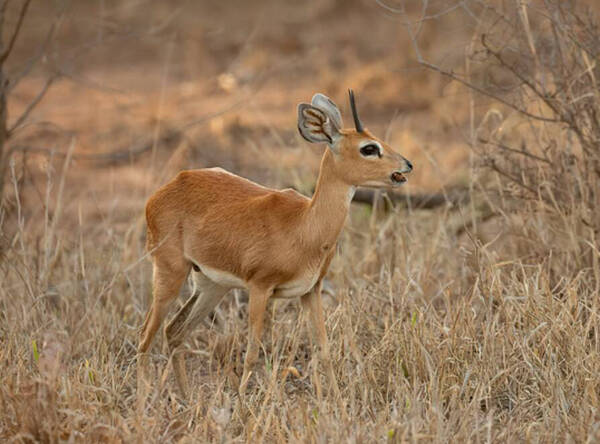Raphicerus sharpei
IUCN
LCBasic Information
Scientific classification
- name:Raphicerus sharpei
- Scientific Name:Raphicerus sharpei
- Outline:Ungulata
- Family:Artiodactyla Bovidae Stag
Vital signs
- length:65-75cm
- Weight:7-16kg
- lifetime:About 10 years
Feature
There is a white ring around the eyes and along the sides of the muzzle that extends into the nasal cavity
Distribution and Habitat
Distributed in Botswana, Democratic Republic of Congo, Eswatini, Malawi, Mozambique, South Africa, Tanzania, Zambia and Zimbabwe.
The distribution range starts in western and southern Tanzania, southwards through southeastern Democratic Republic of Congo, Zambia (east of the Zambezi River), Malawi, Mozambique (excluding coastal forest areas), to northeastern and eastern Botswana, Namibia, most of Zimbabwe, northeastern South Africa (Limpopo Province, eastern Mpumalanga) and the Caprivi Strip in eastern Swaziland.
It can survive in a variety of habitats, but is most common in rocky and hilly areas. They avoid large areas of tall grass over 50 cm, lying in some areas with shrubs, and often live in secondary forests. Prefers living in woodlands, which is associated with areas with good ground cover, with low shrubs or medium-length grasses growing in the form of good concealment. They also occur in pure Colophospermum mopane stands with little good cover in Hwange National Park, whi
Appearance
The Shamrock is small, weighing 7-16 kg, 45-55 cm tall, with a head-body length of 65-75 cm and a tail length of 4-8 cm. Only males have horns, which are about 5 cm long. The largest recorded muzzle length is more than twice the normal length, at 10.48 cm. Females of this species are slightly larger than males, but there is no information on the range of individuals.
Body color is light red to reddish brown with white spots in the middle, making the species look a bit gray. The sides of the face, forehead, upper part of the muzzle and the outside of the limbs are yellow-brown. The abdomen, lower neck, inner legs and ears are light yellow. There is a white ring around the eyes, extending along the sides of the muzzle to the nasal cavity.
Normal tooth order is 0/3, 0/1, 3/3, 3/3. In 1964, only one case of abnormal dentition was found in 121 specimens examined from a small area in Southern Rhodesia (accounting for 0.83%). The anomaly was found in a female schafer with upper canine t
Details
Sharpe's Grysbok (scientific name: Raphicerus sharpei) is called Sharpe's Grysbok in English, Grysbok de Sharpe in French, Sharpe se Grysbok in South Africa, and Sharpegreisbok in German. There is no subspecies.

The Shamrock is easily distinguished from other members of the genus. The Shamrock lacks a false hoof, the Lesser Shamrock does not, and the Black-eared Shamrock does.
The Shamrock is a secretive animal that usually spends most of the day hiding and lying in the bushes and grass. They are active most of the time at night. Although most are solitary, a pair of Shamrocks or a female with a young can be seen. Shamrocks are territorial animals, usually defending a territory alone, but sometimes in pairs. Shamrocks, like other species of the genus, have eye and facial glands that are used for scent-based communication. In addition, these animals use touch communication during combat and mating, and between females and their offspring, and some physical and visual communication occurs.
Territorial combat among male Shamrocks is less ritualized than that of most antelopes, with males simply stepping forward into combat, kneeling, and stabbing or touching their short horns. When frightened by a predator, the Satsuma rarely runs, but instead lies flat with its head and neck stretched out until the predator approaches on top of them.

All members of the genus Satsuma are herbivores and herbivores. Wilson examined the stomachs of 91 specimens of the schafer in a study in southeastern Zimbabwe, and found that plant matter made up 70% of the stomach contents. The schafer feeds on fruit and roots and tubers dug out with the hoof. They apparently do not need much water, but will drink it if it is available.
There are no detailed information on the mating system of the schafer. However, other members of the genus may be polygamous or may form pairs to jointly defend a territory. These animals may be similar to their conspecifics. The schafer breeds year-round. Most records show a peak breeding season between November and December. Peak calving coincides with the onset of spring rains in southern Africa. Gestation is approximately 180 days (range 168-210 days), with 1-2 calves per litter. Weaning of the young will begin at 3 months of age, and both sexes will reach sexual maturity after 6-19 months.
East (1999) summarized the recorded population density estimates of the species as 0.3-0.7 per square kilometer and estimated the total population size at about 95,000 animals. The sassy antelope is mainly nocturnal, particularly shy and secretive, and in reality it can be overlooked in areas where it is quite common, so they may be more abundant than imagined.
Listed in the IUCN Red List of Threatened Species in 2016 ver3.1 - Least Concern (LC).
Protect wild animals and stop eating game.
Maintaining ecological balance is everyone's responsibility!








